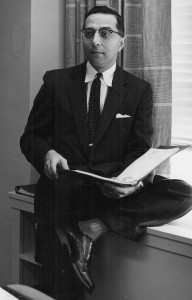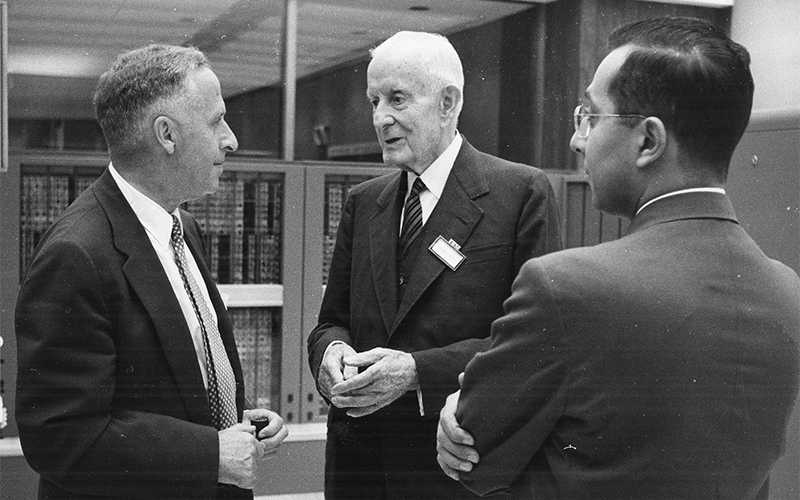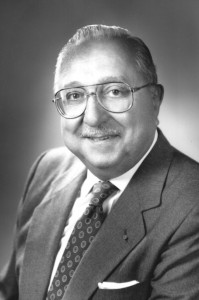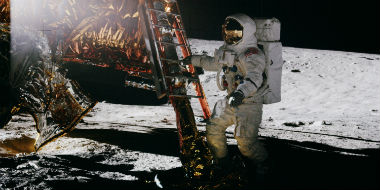In Memoriam
Jerrier A. Haddad: An Appreciation
April 5, 2017 | Written by: IBM THINK Blog
Categorized: In Memoriam | Innovation
Share this post:

Haddad
Many college students hold part-time jobs. Jerry Haddad took a job at IBM while a student at Cornell – and embarked upon a 38-year career in which he helped lead IBM into the computer age.
Haddad, one of IBM’s titans of technology, died on March 31, 2017 at the age of 94.
The child of Syrian immigrants, Haddad grew up in New York City and joined IBM prior to graduating with an electrical engineering degree from Cornell, starting out in the company’s Endicott Engineering Lab – which he later managed. Haddad also managed the Poughkeepsie Lab, and quickly rose through the IBM ranks. He was a leader of several development and engineering teams that focused on large-scale computing – the precursor of the mainframe era – before coming to IBM corporate headquarters as a senior engineering executive in 1963.

Haddad (r), Thomas J. Watson, Sr. (c), in 1955.
Four years later, Haddad was named IBM’s vice president for engineering, programming and technology, and he held that role as IBM became synonymous with enterprise computing. Haddad also led IBM’s technical personal development efforts before his 1981 retirement – and he was responsible for hiring thousands of technical talent during IBM’s mainframe era.
One of those hired was a Ph.D in materials engineering, a young physicist named John Kelly. Today, Dr. Kelly is Haddad’s successor as IBM’s top technical leader and the company’s senior vice president for Cognitive Solutions and Research.
“Jerry Haddad became an industry icon through his leadership of the development of the System 701, a critical step in mass produced electronic computers,” Dr. Kelly said. “He had a unique blend of technical, management and business skills, and he had a great eye for talent. A lot of great technical leaders did their best work because they were hired, promoted and encouraged by Jerry Haddad.”
The holder of 19 patents for inventions in the computer and electronics fields, Haddad was elected to the National Academy of Engineering in 1968.

Jerrier A. Haddad
Haddad was active in retirement, serving as a trustee of Clarkson University and the Webb Institute of Naval Architecture, as well as chairman of the advisory committee at Cornell’s college of engineering. He received Honorary Doctorates from Union College and Clarkson College, and served as a member of the science and technology transition team for President Ronald Reagan in 1981.
Haddad is survived by his wife of 43 years, Carol, five children, 14 grandchildren, 10 great-grandchildren – and countless people whom he mentored over the years.
“Jerry literally had IBM at the edge of all new system-level thinking and technology,” said Nicholas M. Donofrio, one of those many executives Haddad encouraged; Donofrio rose through the technical ranks to become an IBM Fellow and Executive Vice President for Innovation and Technology. “He pushed us hard to create the future, but was also bright enough to know when to allow the team to take technology to market.”
“Seeing the future is one thing – leading the team there is another,” Donofrio said. “Jerry Haddad was terrific at both.”
AI in 2020: From Experimentation to Adoption
AI has captured the imagination and attention of people globally. But in the business world, the rate of adoption of artificial intelligence has lagged behind the level of interest through 2019. Even though we hear that most business leaders believe AI provides a competitive advantage, up until recently, some industry watchers have pegged enterprise adoption […]
On Another Apollo Anniversary, a Reminder: IBM Space Technology Continues to Evolve
History’s publicists have done well by Apollo 11 and Neil Armstrong’s first moon steps in July 1969. However, fewer recall the Apollo 12 lunar mission four months later. It almost didn’t happen. On Nov. 14, 1969, in the first minute after lift-off, two lightning bolts struck Apollo 12. The spacecraft’s main power supply went dark, […]
The Apollo 11 Lessons We Live by Today
In 1969, more than 4,000 IBMers worked alongside NASA to land Apollo 11 on the moon. And for each day of the many months they worked writing code, programming computers and running simulations, they never stopped thinking: What else could we do? What contingency can we plan for? What are we forgetting? In fact, it […]



